We have been in the warehouse racking business for over twenty years. Over this time, working with buyers from all over the world, we’ve noticed a recurring issue: some buyers are simply unsure about which type of racking system they should choose.
So today, I want to address this very important question in a dedicated guide: how to choose the right warehouse storage rack?

Four Core Questions You Must Clarify Before Making a Decision
Analyze Your Inventory Information
What are your goods like? When selecting a racking type, it is crucial that we base our choice on the nature of your items!
The main questions here are:
- What are the dimensions, weight, and material of your goods (Are they fragile? Do they require dust protection?)
- Do you have a single SKU or complex, mixed categories of products?
- Are they fast-moving consumer goods (FMCG), slow-moving items, or seasonal products?
- What is your storage unit: pallets, totes, cartons, or individual pieces?
Evaluate Your Operational Model
- What is your access mode?
Is it “high volume, low frequency” for full pallet storage and retrieval, or “low volume, high frequency” for piece picking operations? - What are your efficiency requirements?
Is First-In, First-Out (FIFO) mandatory? How critical is your order fulfillment speed? - What about labor and equipment?
What type of forklift is used (e.g., counterbalance, reach truck, VNA narrow-aisle truck)? What is the level of automation?
Measure Your Warehouse Space
The length, width, clear height, column locations, and door positions are critical measurements you need to provide. When purchasing racking, the rack dimensions must not only fit your goods but also fit inside your actual warehouse. A professional warehouse layout design is also essential to plan a scientific and effective racking arrangement.
Define Your Budget and Future Plan
Ultimately, the procurement of warehouse racking must align with your budget, including long-term costs like installation, maintenance, operation (e.g., energy consumption), and labor.
We also need to consider scalability and flexibility. For instance, what growth is anticipated for the business over the next 3-5 years? Can the racking system be quickly and economically adapted to future changes?
Mainstream Warehouse Racking Systems and Their Applications
Next, I will introduce several common warehouse racking systems based on typical use cases. If you have a very specific or unusual requirement, please feel free to contact us, and we would be happy to provide a complimentary, custom-tailored storage solution.
Without further ado, let’s dive into the details!
General-Purpose Racking
Heavy-duty pallet racking is suitable for almost all types of warehouses, especially scenarios with diverse product categories, frequent access, and a requirement for First-In, First-Out (FIFO) management. Examples include raw material or finished goods warehouses in manufacturing, e-commerce fulfillment centers, and third-party logistics (3PL) warehouses. This is why it is the most common type of racking we encounter.
Heavy-duty pallet racking is primarily composed of upright frames, beams, and cross beams, featuring a simple yet robust structure. The product’s iterations and evolution have made it a very mature solution today.
Its advantages include strong versatility, simple structure, easy installation, FIFO access, and a relatively low purchase cost. Its main drawback is lower space utilization, primarily because sufficient space must be reserved for forklift operation aisles.

Space-Saving Racking
Very Narrow Aisle (VNA) Racking
VNA racking is essentially an optimization derived from heavy-duty pallet racking. The most distinguishing feature of this system is its exceptionally narrow aisles. Therefore, if you choose this system, you must use specialized turret trucks or tri-lateral stacker forklifts.
Pros and Cons:
Pros: Excellent space utilization, typically increasing storage capacity by about 30% compared to standard heavy-duty pallet racking. It maintains the same FIFO access method as standard pallet racking.
Cons: The need for specialized forklifts results in a higher initial investment cost, and forklift operators require more specialized training. Due to the increased height of the racks, there are also stricter requirements for the flatness of the warehouse floor.
Ideal Applications: Industries where warehouse clear height is high (typically > 10m), storage volume is large, and goods have high value or require fast access. Examples include cold storage facilities (where land costs are extremely high), food and beverage, and high-end manufacturing.
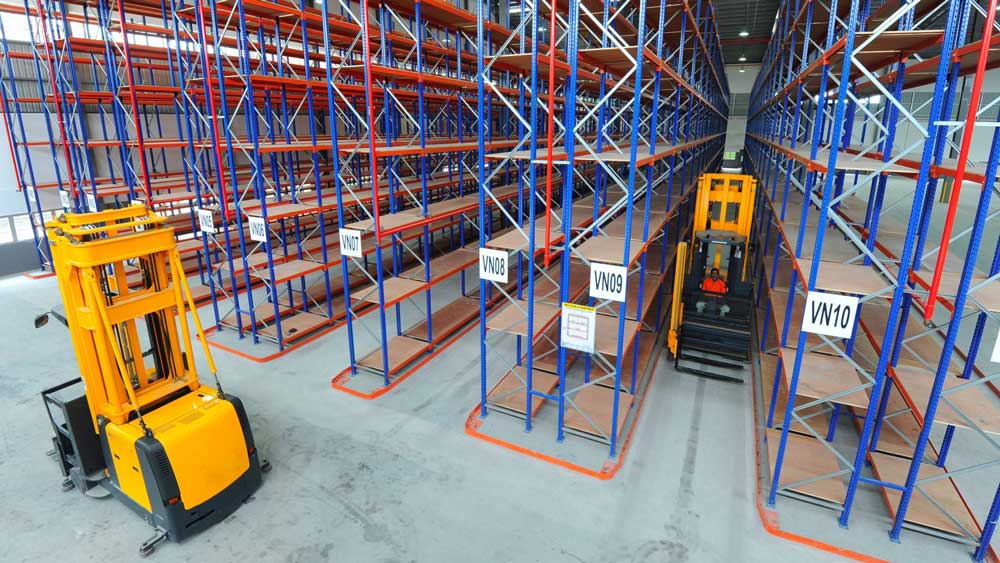
Drive-In Racking
The appearance of drive-in racking is quite unique; you can think of its design as resembling a tunnel. Forklifts drive directly into the lane entrance and place the goods on the cantilever rails or guide rails along the sides of the lane. Because of this design, it doesn’t have the standard horizontal beams we commonly see.
Its pros and cons are both related to its unique design.
Advantages: Since the drive-in racks effectively integrate the aisle space, eliminating the need for separate aisles for forklift maneuvering, the space utilization is very high.
Disadvantages: It uses a Last-In, First-Out (LIFO) access method, making retrieval less flexible. Furthermore, because the aisles are integrated into the rack structure, it demands high skill from the forklift drivers, and stability is relatively lower.
Ideal Applications: Storage of single-SKU, high-volume, low-turnover goods. Examples include beverages, building materials, and chemical products.
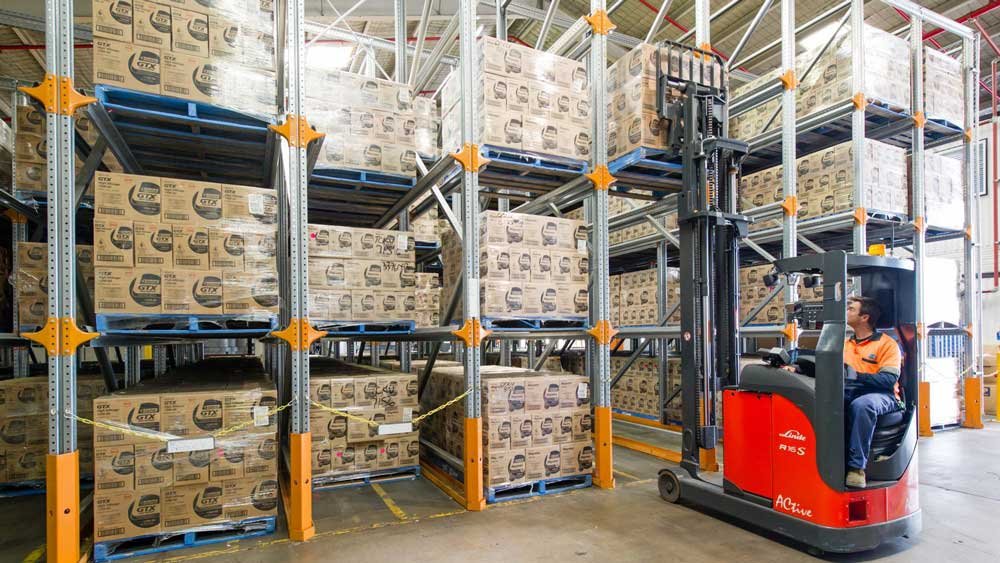
Push-Back Racking
Push-back racking shares a similar appearance with drive-in racking but differs fundamentally. It features rails and carts (or trollies) set up along the depth of the rack. When storing goods, a new pallet pushes the previously stored pallets deeper into the system. When retrieving, the outermost pallet is removed, and the pallets behind it automatically slide forward to the retrieval end due to gravity.
Pros and Cons:
Pros: It is slightly more flexible than drive-in racking, allowing for a form of partial FIFO. Space utilization remains very high.
Cons: The structure is relatively complex, leading to higher manufacturing costs, and it requires high-quality pallet bases.
Ideal Applications: Storage for more product varieties than drive-in, but still suited for large-batch volumes where extreme retrieval efficiency is not the absolute priority. The high-density shelving systems in libraries operate on a similar principle.
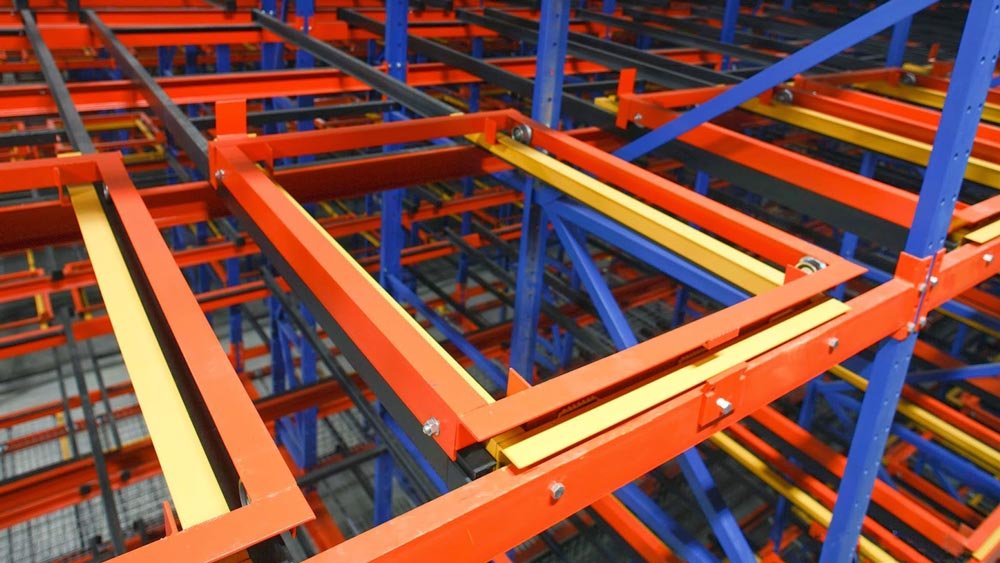
Flexible and Efficient Racking
Light and Medium-Duty Shelving (Shelving Racks)
This type of shelving is composed of uprights and deck panels (steel or wood) and is typically used for manual storage and retrieval. Warehouse staff can walk directly up to the rack and manually pick or store cartons or loose items. You can even think of it as a super-sized bookcase.
Pros and Cons:
Pros: Low cost, flexible structure, and intuitive, convenient access.
Cons: Limited load-bearing capacity, and height is restricted by manual operation limits.
Ideal Applications: Storing small items, tools, spare parts, and electronic components, commonly found in corporate tool rooms and e-commerce split-case picking areas.

Carton Flow Racking
You can visualize this as a shelving rack where the horizontal levels are fitted with rollers or wheels and set at a slight incline. Goods are loaded from the back (loading end) and automatically slide to the front (picking end) using gravity, thereby achieving First-In, First-Out (FIFO).
Pros and Cons:
Pros: Extremely high picking efficiency, significantly reducing the walking distance for pickers.
Cons: Has certain requirements for the packaging and specifications of the goods to ensure smooth sliding.
Ideal Applications: E-commerce order picking, production line material supply, pharmaceutical picking, and other processes that require fast, batch processing of SKUs.
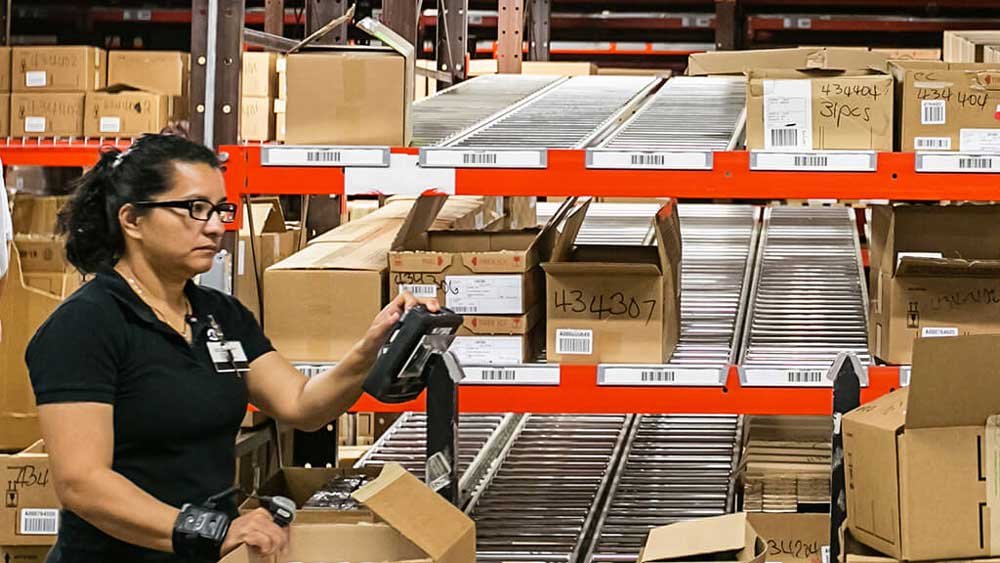
Automated and Intelligent Racking
Automated Storage and Retrieval System (AS/RS)
This system typically consists of extremely tall racking structures, automated stacker cranes, an in/out conveyor system, and a central control system. The entire workflow is computer-controlled, with stacker cranes automatically traveling in narrow aisles to precisely store and retrieve goods.
Pros and Cons:
Pros: Maximizes space utilization, enables unmanned operation, and achieves extremely high efficiency, accuracy, and intelligent management.
Cons: Requires massive initial investment, demands high system maintenance, and offers poor flexibility for modification.
Ideal Applications: Large enterprises with stringent demands for logistics efficiency and space utilization, such as the tobacco, pharmaceutical, automotive, and high-tech electronics industries.
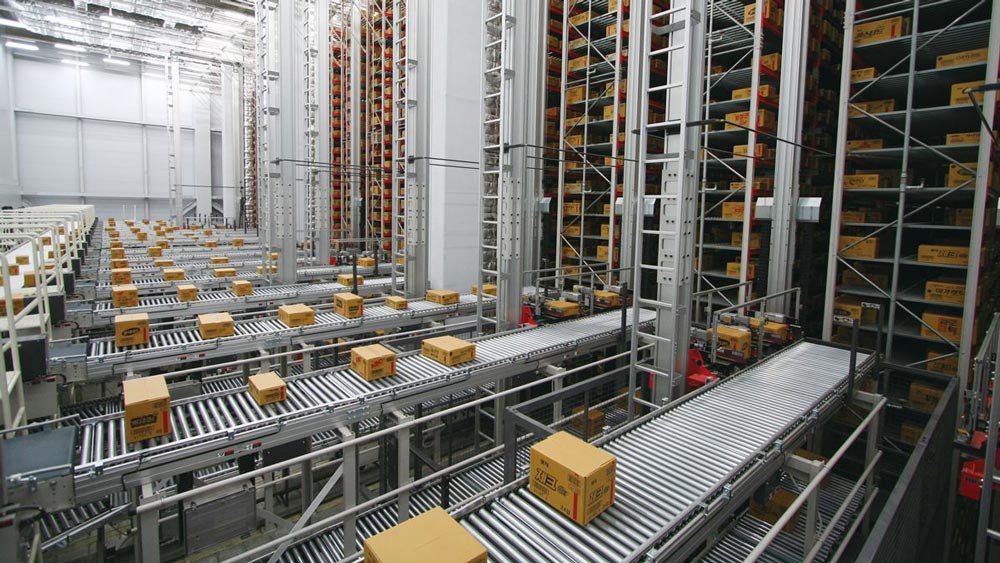
How to Evaluate a Supplier’s Professional Competence
Design Capability
Generally, a professional supplier will deeply understand your business model, product characteristics, future growth plans, and your current pain points. They are designing a comprehensive solution for you, not just selling racks.
They should provide a detailed proposal that includes a layout plan, 3D renderings, load-bearing calculations, and an explanation of how the design solves your specific problems (for example, “We are using a VNA design here to increase your space utilization by 20%”).
Be cautious of suppliers who quote a single price based only on your verbal description without asking for specifics, or who simply use a “one-size-fits-all” template.
Product Quality
First, you can ask your supplier to clearly state the type of steel used (e.g., Q235B) and whether the thickness meets the required standards.
Next, we need to focus on manufacturing details:
- Upright Frames: The key parameter here is the professional index called the Moment of Inertia of the section. Simply put, for the same weight, a more reasonable structure (like a butterfly hole profile) offers better load capacity and stability. They should be able to show you a cross-section diagram and explain this.
- Beams: Look at the connection method between the beam and the upright. The safety pin is a critical component; they should be able to demonstrate its physical model and explain its anti-dislodgement mechanism.
- Surface Treatment: This is typically powder coating. Check if the coating is uniform, smooth, and has strong adhesion (you can request a scratch test with a hard object). This affects the rack’s rust prevention and lifespan.
Finally, check for credible certifications:
They should be able to provide material certificates for the raw steel and third-party inspection reports for the finished product (especially critical load-bearing capacity tests and seismic resistance reports).
Service Level
Evaluate their service during the pre-sales consultation: Are they patient and professional, much like I am now answering your questions?
During sales communication, is there a dedicated project manager coordinating the work, providing timely progress updates, and proactively communicating solutions for any issues?
For after-sales service, do they offer a clear warranty period (for structural integrity, surface treatment, etc.)? Do they have a rapid response mechanism for things like spare parts supply or damage repair? Can they provide regular safety training and free follow-up inspection visits?
Conclusion
In closing, I hope you understand that the cheapest quote is often the biggest cost trap. Unprofessional suppliers may cut corners on materials, manufacturing processes, and service, which can ultimately lead to rack deformation, safety hazards, or even collapse. The resulting losses will far outweigh the money you initially saved.
Choosing a professional supplier safeguards your warehouse safety, operational efficiency, and long-term investment. May this guide empower you to make confident and informed decisions when selecting and procuring storage shelving!

